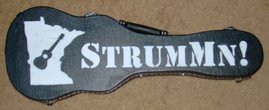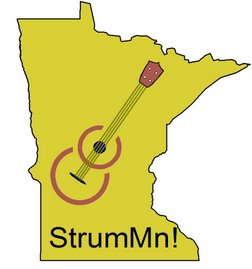First things first. I cut the carbon fiber rods in half, cleaned up the ends, then epoxied them into the neck.
I used about half of the epoxy and the package said to toss the "mixing applicator" and then cap the syringes. Well that seemed like a waste and I had the compressor hose a few feet away... so I blew out the applicator. Then ran a little mineral spirits through it, followed by more air. Decided to blow air through backwards and the spiral mixing bit inside blew out. Convenient! Now I wrapped a half inch wide bit of paper towel around a 1/8" saw blade and was able to run it into the applicator and spin it around getting it squeaky clean and all ready for next use.
Next up was headstock shape. I'd looked at a few online for inspiration and liked some aspects of this Epiphone shape.
So next I looked around the shop for anything curved to try to trace for the sides. I found a cookie tin (saving for a cigar box type build), the form for the body on this uke, and the cast iron platform for my jigsaw. Jigsaw it was! But, it still took 3 tries for the right side and 2 for the left to trace lines the way I wanted. I decided on the S shape for the top rather than the "open book" and I just freehanded that. You may have noticed that it's asymmetrical, that's because as a 5 string it'll have 3 tuners on the left and 2 on the right. Leaving a little extra space on the right also helps ensure the hand isn't jammed up again the tuner there.
After cutting the headstock shape on the band saw I realized that I was missing about 1/8" on the face side at the top (I'd traced the shape on the back side). I just freehanded the extra 1/8" on the band saw and then went to the oscillating spindle sander to smooth everything up. I'm liking it!
And finally, I worked on my 2 book matched plates for the back. Ran them through the jointer to get perfect edges to glue together (but still hand sanded them just a bit). I then cut them to width and length and set up my edge gluing jig. I'm using different glue than I've used before, Apel waterproof polyurethane made for boats and supposed to be heat resistant and waterproof. After the back gets glued up I intend to curve it in my go-bar deck to an 8 foot radius, which might require heat and moisture. I'm thinking about using the clothing steamer my wife got a while back while clamping in the go-bar deck.
For now it's clamped up with a milling vise sitting on top to hold it down flat.






































.jpg)













